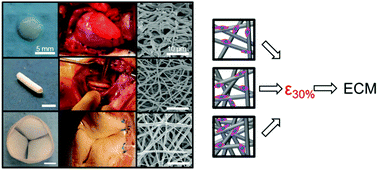当前位置:
X-MOL 学术
›
Soft Matter
›
论文详情
Our official English website, www.x-mol.net, welcomes your feedback! (Note: you will need to create a separate account there.)
Meso-scale topological cues influence extracellular matrix production in a large deformation, elastomeric scaffold model†
Soft Matter ( IF 3.4 ) Pub Date : 2018-10-16 00:00:00 , DOI: 10.1039/c8sm01352g Antonio D'Amore 1, 2, 3, 4, 5 , Gabriele Nasello 1, 2, 3, 4, 5 , Samuel K. Luketich 1, 2, 3, 4, 5 , Dima Denisenko 1, 2, 3, 4, 5 , Daniel L. Jacobs 1, 2, 3, 4, 5 , Richard Hoff 1, 2, 3, 4, 5 , Gregory Gibson 4, 5, 6, 7 , Alessandro Bruno 8, 9, 10, 11 , Manuela T. Raimondi 11, 12, 13, 14, 15 , William R. Wagner 1, 2, 3, 4, 5
Soft Matter ( IF 3.4 ) Pub Date : 2018-10-16 00:00:00 , DOI: 10.1039/c8sm01352g Antonio D'Amore 1, 2, 3, 4, 5 , Gabriele Nasello 1, 2, 3, 4, 5 , Samuel K. Luketich 1, 2, 3, 4, 5 , Dima Denisenko 1, 2, 3, 4, 5 , Daniel L. Jacobs 1, 2, 3, 4, 5 , Richard Hoff 1, 2, 3, 4, 5 , Gregory Gibson 4, 5, 6, 7 , Alessandro Bruno 8, 9, 10, 11 , Manuela T. Raimondi 11, 12, 13, 14, 15 , William R. Wagner 1, 2, 3, 4, 5
Affiliation

|
Physical cues are decisive factors in extracellular matrix (ECM) formation and elaboration. Their transduction across scale lengths is an inherently symbiotic phenomenon that while influencing ECM fate is also mediated by the ECM structure itself. This study investigates the possibility of enhancing ECM elaboration by topological cues that, while not modifying the substrate macro scale mechanics, can affect the meso-scale strain range acting on cells incorporated within the scaffold. Vascular smooth muscle cell micro-integrated, electrospun scaffolds were fabricated with comparable macroscopic biaxial mechanical response, but different meso-scale topology. Seeded scaffolds were conditioned on a stretch bioreactor and exposed to large strain deformations. Samples were processed to evaluate ECM quantity and quality via: biochemical assay, qualitative and quantitative histological assessment and multi-photon analysis. Experimental evaluation was coupled to a numerical model that elucidated the relationship between the scaffold micro-architecture and the strain acting on the cells. Results showed an higher amount of ECM formation for the scaffold type characterized by lowest fiber intersection density. The numerical model simulations associated this result with the differences found for the change in cell nuclear aspect ratio and showed that given comparable macro scale mechanics, a difference in material topology created significant differences in cell–scaffold meso-scale deformations. These findings reaffirmed the role of cell shape in ECM formation and introduced a novel notion for the engineering of cardiac tissue where biomaterial structure can be designed to both mimick the organ level mechanics of a specific tissue of interest and elicit a desirable cellular response.
中文翻译:

中尺度拓扑线索影响大变形弹性体支架模型中细胞外基质的产生†
物理提示是细胞外基质(ECM)形成和加工的决定性因素。它们跨尺度长度的转导是一种固有的共生现象,在影响ECM命运的同时也由ECM结构本身介导。这项研究调查了通过拓扑线索增强ECM加工的可能性,该线索虽然没有改变底物的宏观尺度力学,但可以影响作用于支架内细胞的介观尺度应变范围。血管平滑肌细胞微集成的电纺支架具有可比的宏观双轴机械响应,但具有不同的介观拓扑结构。播种的支架在拉伸生物反应器上进行调节,并暴露于大的应变变形中。样品进行处理,以评估ECM数量和质量通过:生化分析,定性和定量组织学评估以及多光子分析。实验评估与数值模型相结合,该数值模型阐明了支架微结构与作用于细胞的应变之间的关系。结果表明,以最低的纤维交叉密度为特征的支架类型的ECM形成量更高。数值模型模拟将此结果与发现的细胞核长宽比变化的差异相关联,并表明,在具有可比的宏观尺度力学的情况下,材料拓扑结构的差异会导致细胞-支架中尺度变形的显着差异。
更新日期:2018-10-16
中文翻译:

中尺度拓扑线索影响大变形弹性体支架模型中细胞外基质的产生†
物理提示是细胞外基质(ECM)形成和加工的决定性因素。它们跨尺度长度的转导是一种固有的共生现象,在影响ECM命运的同时也由ECM结构本身介导。这项研究调查了通过拓扑线索增强ECM加工的可能性,该线索虽然没有改变底物的宏观尺度力学,但可以影响作用于支架内细胞的介观尺度应变范围。血管平滑肌细胞微集成的电纺支架具有可比的宏观双轴机械响应,但具有不同的介观拓扑结构。播种的支架在拉伸生物反应器上进行调节,并暴露于大的应变变形中。样品进行处理,以评估ECM数量和质量通过:生化分析,定性和定量组织学评估以及多光子分析。实验评估与数值模型相结合,该数值模型阐明了支架微结构与作用于细胞的应变之间的关系。结果表明,以最低的纤维交叉密度为特征的支架类型的ECM形成量更高。数值模型模拟将此结果与发现的细胞核长宽比变化的差异相关联,并表明,在具有可比的宏观尺度力学的情况下,材料拓扑结构的差异会导致细胞-支架中尺度变形的显着差异。



























 京公网安备 11010802027423号
京公网安备 11010802027423号